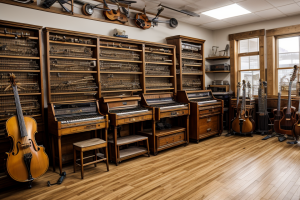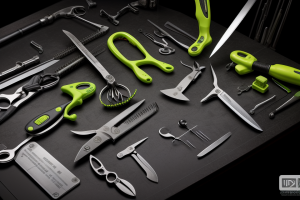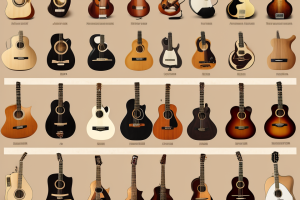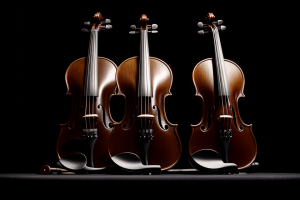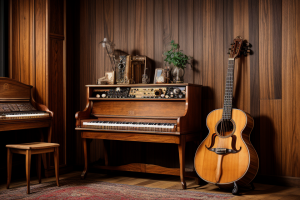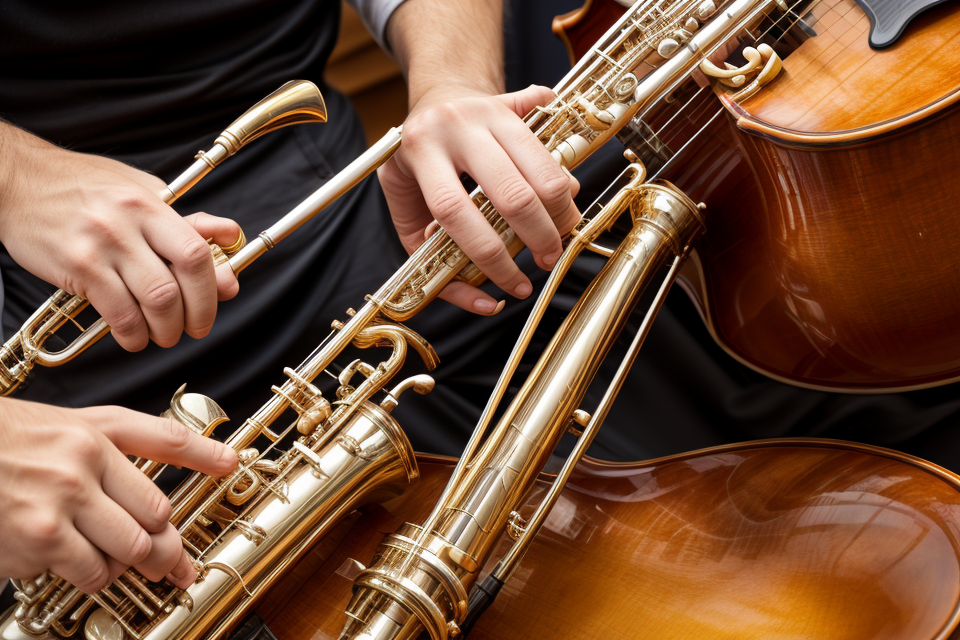
Instruments are an essential part of our daily lives, and they come in all shapes and sizes. From musical instruments to scientific equipment, these tools help us to explore and understand the world around us. However, like any other tool, instruments can break or malfunction, and when they do, it’s important to know how to fix them. In this comprehensive guide, we’ll explore everything you need to know about instrument repairs, from the basics of fixing musical instruments to the intricacies of repairing scientific equipment. So, whether you’re a professional instrument repair technician or a hobbyist, this guide has something for everyone. Let’s dive in and explore the fascinating world of instrument repairs!
What are Instrument Repairs?
The Importance of Regular Maintenance
Regular maintenance is crucial for any instrument, as it helps to ensure that it continues to function properly and to prevent costly repairs in the future. This section will cover the importance of regular maintenance for various types of instruments, including stringed instruments, woodwind instruments, and brass instruments.
Benefits of Regular Maintenance
Increased Longevity
Regular maintenance can help to extend the life of an instrument. This is because it allows for any potential issues to be identified and addressed before they become major problems. For example, if a stringed instrument’s neck becomes misaligned, it can cause the instrument to go out of tune and potentially lead to more serious damage if left untreated.
Improved Performance
Regular maintenance can also improve an instrument’s performance. For example, regularly cleaning and oiling the moving parts of a woodwind instrument can help to ensure that it stays in tune and that the keys move smoothly. Similarly, regular cleaning and polishing of a brass instrument’s valves and slides can help to prevent buzzing and other issues that can affect the sound quality.
Cost Savings
Finally, regular maintenance can save money in the long run. By addressing small issues before they become major problems, instruments can be repaired more easily and at a lower cost. This is particularly important for musicians who rely on their instruments for their livelihood, as even a short period without an instrument can be financially devastating.
In conclusion, regular maintenance is essential for any instrument. Whether it’s a stringed instrument, woodwind instrument, or brass instrument, regular upkeep can help to increase longevity, improve performance, and save money in the long run.
Types of Instrument Repairs
Instrument repairs refer to the process of restoring damaged or malfunctioning musical instruments to their optimal condition. These repairs can range from minor adjustments to more extensive restorations, depending on the extent of the damage. Here are some of the most common types of instrument repairs:
- Crack repair: This type of repair involves fixing cracks or splits in the instrument’s body or neck. Cracks can occur due to changes in temperature and humidity, accidental drops, or even the natural aging process. A skilled repairperson will assess the severity of the crack and use appropriate methods to repair it, such as gluing or clamping the crack together.
- Fretwork: Fretwork refers to the maintenance and repair of the instrument’s frets, which are the metal wires that run along the neck of the guitar. Over time, the frets can become worn or damaged, causing buzzing or fret buzz. A fretwork repair will involve leveling, dressing, or replacing the frets to restore the instrument’s playability.
- Neck reset: A neck reset is a more extensive repair that involves adjusting the angle of the neck in relation to the body of the guitar. This is typically done when the neck has become warped or twisted, which can happen due to changes in temperature and humidity or from impacts. A skilled repairperson will carefully adjust the neck to ensure proper alignment and improve the instrument’s playability.
- Bridge repair or replacement: The bridge is the structure that holds the strings in place and transfers their vibrations to the body of the guitar. Over time, the bridge can become worn, damaged, or misaligned, which can affect the instrument‘s tuning and playability. A bridge repair or replacement will involve assessing the damage and either repairing or replacing the bridge to restore the instrument’s performance.
- Electronics repair: Electric guitars and basses often have electronic components such as pickups, pots, and wiring that can malfunction or wear out over time. A qualified repairperson can diagnose and repair any electrical issues, ensuring that the instrument’s electronics are functioning properly.
- Finish repair: The finish of an instrument refers to the surface coat or layer that protects and enhances the appearance of the wood. Over time, the finish can become scratched, dented, or worn, which can affect the instrument‘s appearance and value. A skilled repairperson can perform touch-ups or more extensive refinishing to restore the finish to its original condition.
Understanding the different types of instrument repairs can help you identify the specific issues your instrument may be experiencing and seek out the appropriate professional help. Whether it’s a simple crack repair or a more extensive neck reset, proper repairs can restore your instrument to its optimal condition and ensure many more years of musical enjoyment.
Tuning and Adjustments
Understanding the Importance of Tuning and Adjustments
Tuning and adjustments are crucial components of instrument repairs. The proper tuning and adjustments of an instrument can greatly affect its sound quality and playability. Regular maintenance and adjustments can help to prevent damage and extend the life of the instrument.
Common Instruments Requiring Tuning and Adjustments
Many musical instruments require regular tuning and adjustments, including guitars, violins, cellos, and violas. The frequency at which tuning is required can vary depending on the instrument and its usage. For example, a guitar that is played frequently may require tuning before each session, while a cello that is only played occasionally may only need tuning once a week.
Proper Tuning Techniques
Proper tuning techniques can help to ensure that the instrument sounds its best. There are different tuning methods for different instruments, and it is important to use the correct method for each instrument. For example, a guitar can be tuned using a tuner or by ear, while a cello requires a tuning fork or a cello tuner.
Adjustments
In addition to tuning, adjustments may also be necessary to ensure that the instrument is playing properly. This can include adjusting the truss rod on a guitar, adjusting the pegs on a stringed instrument, or adjusting the bridge on a woodwind instrument. These adjustments can help to improve the playability and sound quality of the instrument.
Benefits of Regular Tuning and Adjustments
Regular tuning and adjustments can help to prevent damage to the instrument and ensure that it is playing at its best. This can help to extend the life of the instrument and keep it in good condition for years to come. Additionally, regular maintenance can help to maintain the value of the instrument, as it can affect its resale value.
Replacing Parts and Accessories
Instrument repairs involve fixing any damages or malfunctions in musical instruments to restore them to their optimal condition. Replacing parts and accessories is one of the common types of repairs that instrument owners may need to undertake. In this section, we will discuss the process of replacing parts and accessories in musical instruments.
Types of Instrument Parts and Accessories
There are various types of parts and accessories that can be found in musical instruments. These include:
- Strings: These are the wires that produce sound when plucked or strummed.
- Picks: These are small tools used to play stringed instruments.
- Nuts and bolts: These are used to secure and tighten parts together.
- Bridge: This is a small structure that supports the strings and helps transfer the vibrations to the body of the instrument.
- Fretboard: This is the part of the instrument where the strings are pressed down to produce different notes.
- Frets: These are small metal bars that are placed on the fretboard to create different notes.
Replacing Parts and Accessories
Replacing parts and accessories in musical instruments can be a complex process, especially if the instrument is old or has been heavily used. Here are some steps to follow when replacing parts and accessories:
- Identify the damaged or worn-out part: The first step is to identify the part that needs to be replaced. This can be done by examining the instrument and comparing it with a manual or diagram of the instrument.
- Determine the size and shape of the replacement part: Once the damaged part has been identified, the next step is to determine the size and shape of the replacement part. This can be done by comparing the old part with a new one or by measuring the damaged part.
- Remove the old part: After determining the size and shape of the replacement part, the next step is to remove the old part. This can be done using tools such as pliers, screwdrivers, or wrenches.
- Install the new part: Once the old part has been removed, the new part can be installed. This can be done by following the manufacturer’s instructions or by consulting a repair manual.
- Adjust the instrument: After installing the new part, the instrument may need to be adjusted to ensure it is playing correctly. This can involve adjusting the tuning, action, or other aspects of the instrument.
In conclusion, replacing parts and accessories is an important aspect of instrument repairs. By following the steps outlined above, instrument owners can ensure that their instruments are restored to their optimal condition and continue to play for years to come.
Major Overhauls and Restorations
When an instrument requires extensive repair or restoration, it is referred to as a major overhaul. This type of repair involves disassembling the instrument, cleaning and inspecting each component, and replacing any damaged parts.
Here are some steps involved in a major overhaul:
- Disassembly: The instrument is carefully taken apart, and each component is carefully examined for any damage or wear.
- Cleaning: All parts are thoroughly cleaned to remove any dirt, grime, or debris that may have accumulated over time.
- Inspection: Each component is carefully inspected for any signs of damage or wear. This includes checking for cracks or damage to the wood or metal, as well as examining the condition of the mechanisms and tuning pegs.
- Replacement of parts: Any damaged or worn-out parts are replaced with new ones. This may include strings, pads, valves, or other components that have become worn or damaged over time.
- Reassembly: Once all the repairs have been made, the instrument is carefully reassembled, and all parts are adjusted to ensure proper function.
- Final tuning: The instrument is tuned and checked for proper sound quality and functionality.
A major overhaul is typically recommended for instruments that have not been serviced for a long time or have suffered significant damage. It is an investment in the longevity and performance of the instrument, ensuring that it will continue to function properly for years to come.
Common Instruments That Need Repair
Pianos
Pianos are complex musical instruments that consist of many moving parts, which can wear out over time and require repair. Whether it’s a grand piano or an upright piano, regular maintenance and repairs are necessary to keep it in good condition. Here are some common issues that may require piano repairs:
- Keyboard Issues: The keyboard is the most important part of a piano, and any issue with it can affect the entire instrument. Common keyboard issues include stuck keys, broken keys, and uneven key height.
- Soundboard Issues: The soundboard is responsible for amplifying the sound of the piano, and any damage to it can result in a poor-sounding instrument. Common soundboard issues include cracks, warping, and loose ribs.
- Tuning Issues: Pianos need to be tuned regularly to maintain their optimal sound quality. However, over time, the strings can stretch and require additional work to bring them back to pitch.
- Structural Issues: Pianos are large and heavy instruments that require a sturdy frame to support them. Structural issues such as a loose or broken pedal, a loose or missing key, or a cracked or warped frame can affect the overall sound and stability of the piano.
To ensure that your piano is in good condition, it’s important to have it regularly maintained and repaired by a professional piano technician. They will be able to identify any issues and make the necessary repairs to keep your piano sounding its best.
Guitars
Guitars are one of the most popular instruments that require regular maintenance and repairs. There are various parts of a guitar that can wear out or break over time, such as the strings, frets, tuning machines, and body.
Strings
One of the most common repairs for guitars is replacing the strings. Over time, strings can become dull, rusty, or even break during a performance. It’s essential to use high-quality strings that are designed for your specific guitar and playing style. It’s also a good idea to keep an extra set of strings on hand in case you need to make a quick replacement during a performance.
Frets
The frets on a guitar can wear out over time, especially if you play with a heavy hand or use excessive pressure when playing. When the frets wear out, it can affect the playability and tone of the guitar. A professional luthier can repair or replace the frets to restore the guitar’s original condition.
Tuning Machines
The tuning machines on a guitar can also wear out or break over time. If your guitar is having trouble staying in tune, it may be time to replace the tuning machines. A professional luthier can install new tuning machines that are designed to fit your specific guitar and playing style.
Body
The body of a guitar can also sustain damage over time, such as cracks or dents. These types of repairs require the expertise of a professional luthier who can assess the damage and make the necessary repairs to restore the guitar’s original condition.
Overall, regular maintenance and repairs are essential to keep your guitar in good condition and ensure it continues to perform at its best. Whether you need to replace strings, repair frets, or make more significant repairs to the body, it’s important to seek the expertise of a professional luthier who can help you get your guitar back in top condition.
Woodwinds
Woodwinds are a family of musical instruments that include clarinets, saxophones, flutes, and oboes. These instruments are made from wood and produce sound when air is blown through a reed or a mouthpiece. Over time, woodwinds can experience various issues that require repair, such as keys not working, pads not sealing properly, or cracks in the wood or metal.
- Cracks: Cracks can occur in the wood or metal body of the instrument, and they can be caused by drying or shrinking of the wood, changes in temperature and humidity, or physical damage. Cracks can affect the sound quality and playability of the instrument and should be repaired as soon as possible.
- Keywork issues: Woodwinds have a complex system of keys that allow the player to change notes. Over time, the keys can become sticky or loose, and they may need to be oiled or replaced. Additionally, keys can be bent or broken, which requires repair or replacement.
- Pad issues: Woodwinds have pads that are located between the keys and the instrument’s body. These pads can wear out or tear, causing air to leak out of the instrument and affecting the sound quality. Pads can be replaced, and the instrument’s keywork can be adjusted to ensure proper sealing.
- Adjustments and cleaning: Regular maintenance is essential for woodwinds to ensure they remain in good condition. This includes adjusting the instrument’s mechanics, cleaning the instrument with a soft cloth, and oiling the keys and pads. A professional repairperson can provide these services and help extend the life of your woodwind instrument.
Brass Instruments
Brass instruments are a common type of instrument that requires regular maintenance and repair. These instruments include trumpets, trombones, and French horns. The most common repairs for brass instruments include:
- Valve adjustment: Valves are responsible for directing airflow through the instrument, and over time they can become loose or stuck. A professional repair technician can adjust the valves to ensure proper airflow and prevent damage to the instrument.
- Lacquer reconditioning: Brass instruments are often coated with a layer of lacquer to protect the metal and give the instrument its shiny finish. Over time, this layer can wear off or become dull, and it may need to be reapplied by a professional.
- Bell brace repair: The bell brace is a critical component of the brass instrument that helps support the bell. Over time, the bell brace can become loose or damaged, which can affect the sound quality of the instrument. A professional repair technician can repair or replace the bell brace as needed.
- Slide lubrication: The slides on brass instruments can become sticky or corroded over time, which can make playing the instrument difficult. A professional repair technician can lubricate the slides to improve their smoothness and prevent damage to the instrument.
- Key pad replacement: The keys on brass instruments can wear out over time, and a professional repair technician can replace them as needed. This is a complex repair that requires specialized tools and expertise.
Regular maintenance and repair of brass instruments is essential to ensure they continue to play at their best. It is recommended to have a professional technician inspect and repair the instrument at least once a year.
Percussion Instruments
Percussion instruments are a diverse group of instruments that produce sound through striking, shaking, or scraping. These instruments are used in various genres of music, including classical, jazz, and popular music. In this section, we will discuss the common percussion instruments that need repair.
Snare Drum
The snare drum is a popular percussion instrument used in many genres of music. It consists of a shallow, cylindrical body with a head at each end. The snare drum produces a sharp, crisp sound due to the snares, which are metal wires stretched across the bottom head. Over time, the snares can become loose or broken, causing the drum to produce a dull sound. Replacing the snares is a simple repair that can restore the snare drum’s original sound.
Bass Drum
The bass drum is a large, cylindrical drum that produces a deep, resonant sound. It is used in many genres of music, including rock, jazz, and classical music. Over time, the bass drum’s head can become worn or damaged, causing the drum to produce a weak or uneven sound. Replacing the head is a common repair that can restore the bass drum’s sound.
Cymbals
Cymbals are a common percussion instrument used in many genres of music. They consist of a circular plate of metal that produces a bright, clashing sound when struck. Over time, cymbals can become dull or cracked, affecting their sound quality. Replacing the cymbal is a common repair that can restore the instrument’s sound.
Maracas
Maracas are a popular percussion instrument used in many genres of music. They consist of a hollow, cylindrical body filled with small beads or pebbles. Over time, the beads or pebbles can become loose or broken, affecting the instrument’s sound. Refilling the maracas with the correct amount of beads or pebbles is a simple repair that can restore the instrument’s sound.
Tambourine
The tambourine is a percussion instrument that produces a bright, jangling sound. It consists of a frame with pairs of small metal jingles or bells attached to it. Over time, the jingles or bells can become loose or broken, affecting the instrument’s sound. Replacing the jingles or bells is a common repair that can restore the tambourine’s sound.
In conclusion, percussion instruments are a diverse group of instruments that require regular maintenance and repair. Snare drums, bass drums, cymbals, maracas, and tambourines are some of the common percussion instruments that need repair. Replacing broken or worn-out parts, such as snares, cymbals, or jingles, can restore the instrument’s sound and prolong its lifespan. Regular maintenance and repair can help ensure that percussion instruments are always in top condition and ready to be played.
Identifying Issues and Assessing Damage
When it comes to instrument repairs, identifying issues and assessing damage is a crucial first step. Here are some tips to help you get started:
- Visual Inspection: Start by performing a visual inspection of the instrument. Look for any visible signs of damage, such as cracks, dents, or scratches. Check the tuning pegs, bridge, and any other movable parts for loose or broken components.
- Playability Test: Next, test the playability of the instrument. Check for any issues with intonation, tuning stability, or action height. If the instrument is a stringed instrument, make sure the strings are at the proper tension and that there are no buzzing or rattling sounds.
- Listen for Anomalies: Use your ears to detect any anomalies in the instrument’s sound. Listen for any unusual noises, such as buzzing, rattling, or humming. These sounds may indicate a problem with the instrument’s construction or mechanics.
- Use a Digital Tuner: A digital tuner can help you accurately assess the instrument’s tuning and intonation. Plug in the tuner and play a few notes on each string. The tuner will display whether the notes are in tune or not. If the instrument is significantly out of tune, it may need to be adjusted or repaired.
- Check for Rust and Corrosion: If the instrument has metal parts, check for rust and corrosion. Rust and corrosion can cause problems with the instrument’s mechanics and sound quality. Use a soft cloth to wipe away any visible rust or corrosion, and consider taking the instrument to a professional for further assessment if necessary.
By following these steps, you can identify issues and assess damage to your instrument. Knowing what needs to be repaired is the first step in ensuring that your instrument is in top condition and ready to play.
Finding a Reputable Repair Shop
When it comes to having your instrument repaired, it’s important to find a reputable repair shop. Here are some tips to help you find the right place for your instrument repair needs:
- Ask for Recommendations: One of the best ways to find a reputable repair shop is to ask for recommendations from other musicians or music stores. Word-of-mouth referrals can give you a good idea of which shops have a good reputation for quality work.
- Research Online: You can also do some research online to find repair shops in your area. Look for shops that have positive reviews and a good reputation in the music community. Check their website for examples of their work and the types of instruments they repair.
- Check the Certifications: Look for repair shops that are certified by professional organizations such as the National Association of Professional Band Instrument Repair Technicians (NAPBIRT) or the American Musical Instrument Repair Technicians Association (AMIRTA). These certifications ensure that the repair shop has the knowledge and expertise to properly repair your instrument.
- Schedule a Consultation: Before committing to a repair shop, schedule a consultation to discuss your instrument repair needs. This will give you a chance to meet the repair technicians and get a sense of their experience and professionalism. Ask questions about their process and what to expect during the repair process.
By following these tips, you can find a reputable repair shop that will provide you with quality instrument repair services.
Working with a Professional Repair Technician
When it comes to repairing your musical instruments, working with a professional repair technician is often the best course of action. Here are some reasons why:
- Expertise: A professional repair technician has the necessary knowledge and experience to properly diagnose and fix any issues with your instrument. They have been trained in the specific techniques and methods required to repair different types of instruments, and can identify and fix problems that may not be immediately apparent to someone without this expertise.
- Quality of Repairs: A professional repair technician will use high-quality parts and materials to ensure that your instrument is repaired to the highest standards. They will also take the time to carefully inspect and test your instrument after the repair is complete, to ensure that it is functioning properly and is safe to use.
- Saving Time: If you are not familiar with the intricacies of instrument repair, attempting to fix the problem yourself can end up taking a lot of time and effort. A professional repair technician can quickly and efficiently diagnose and fix the problem, saving you time and effort in the long run.
- Extending the Life of Your Instrument: Regular maintenance and repairs by a professional technician can help extend the life of your instrument, keeping it in good condition for years to come.
When looking for a professional repair technician, it’s important to do your research and find someone who has a good reputation and is experienced in repairing the specific type of instrument you have. Ask for recommendations from other musicians or music stores, and read online reviews to get an idea of the quality of their work.
Budgeting for Repairs
When it comes to instrument repairs, budgeting is an essential aspect that cannot be overlooked. It is crucial to consider the cost of repairs when making a decision to repair an instrument. There are several factors that need to be considered when budgeting for instrument repairs.
One of the primary factors to consider is the type of instrument that needs repair. Some instruments, such as string instruments like violins and cellos, can be quite expensive to repair due to their intricate designs and specialized craftsmanship required to repair them. On the other hand, woodwind instruments like clarinets and saxophones may be less expensive to repair since they have fewer moving parts.
Another factor to consider is the extent of the damage. If the damage is extensive, the cost of repairs may be higher. For instance, if the instrument’s body or neck is damaged, it may require more extensive repairs, which can be costly.
Additionally, the location of the repair shop can also impact the cost of repairs. Repair shops in major cities or tourist areas may charge more than those in smaller towns or rural areas. It is essential to research different repair shops and compare their prices before making a decision.
It is also crucial to consider the timeframe for repairs. Some instruments may require immediate repairs, while others can wait. If the instrument is essential for a performance or recording, it may be necessary to prioritize the repairs and pay a premium for a faster turnaround time.
Lastly, it is important to consider the reputation of the repair shop. A reputable repair shop may charge more than an unreputable one, but the quality of the repairs may be better, ensuring that the instrument is in good condition for years to come.
In conclusion, budgeting for instrument repairs requires careful consideration of several factors, including the type of instrument, the extent of the damage, the location of the repair shop, the timeframe for repairs, and the reputation of the repair shop. By considering these factors, you can ensure that you get the best value for your money and that your instrument is in good condition for years to come.
Insurance and Warranties
When it comes to instrument repairs, it’s important to understand the role that insurance and warranties play in the process. Insurance can provide a safety net for instrument owners in the event of damage or loss, while warranties can offer protection against defects and malfunctions.
Here are some key points to keep in mind:
- Insurance policies for musical instruments typically cover damage, theft, and loss. It’s important to carefully review the terms and conditions of your policy to understand what is and isn’t covered.
- Some insurance policies may also cover the cost of repairs, depending on the cause of the damage.
- Warranties for musical instruments usually last for a certain number of years and cover defects or malfunctions that arise during that time. It’s important to understand the terms of your warranty, including what is covered and for how long.
- If you have a warranty or insurance claim, it’s important to document the damage or issue thoroughly. This can help ensure that the repair process goes smoothly and that you receive the appropriate coverage.
Overall, having insurance and a warranty can provide peace of mind and financial protection for instrument owners. However, it’s important to understand the terms and limitations of these policies to make sure you’re fully covered in the event of a repair or other issue.
DIY Repairs and Maintenance
For many musicians, repairing their own instruments can be a rewarding experience that saves time and money. Here are some common repairs that can be done at home:
Cleaning and Polishing
Cleaning and polishing your instrument is an essential part of maintaining it. Here are some steps you can follow:
- Remove any dirt or debris from the instrument using a soft cloth or brush.
- Use a microfiber cloth to wipe down the instrument and remove any dust or smudges.
- Apply a small amount of polish to a soft cloth and use it to buff the instrument to a high shine.
Replacing Strings
Changing the strings on your instrument is a relatively simple task that can greatly improve its sound and playability. Here are some steps you can follow:
- Remove the old strings by loosening them with a tuning key or peg.
- Cut the new strings to the appropriate length using a string cutter or scissors.
- Thread the new strings through the tuning pegs and wind them onto the posts.
- Tune the instrument to the desired pitch using a tuner or piano.
Replacing Pads and Parts
If your instrument has worn or damaged pads or parts, you may be able to replace them yourself. Here are some steps you can follow:
- Disassemble the instrument and remove the damaged pad or part.
- Measure the replacement part to ensure it is the correct size and shape.
- Install the new part and reassemble the instrument.
- Adjust the instrument to the desired pitch and playability.
It’s important to note that while some repairs can be done at home, others may require the expertise of a professional technician. If you’re unsure about any repairs or maintenance tasks, it’s always a good idea to consult with a professional.
The Value of Instrument Repairs for Musicians and Music Lovers
For musicians and music lovers, instrument repairs are a crucial aspect of maintaining the quality and longevity of their musical instruments. A well-maintained instrument can not only improve the sound and performance but also prevent costly repairs or replacements in the future.
Improved Sound and Performance
Regular instrument repairs can help ensure that the instrument is in optimal condition, resulting in improved sound quality and overall performance. This is particularly important for musicians who rely on their instruments for their livelihood or for those who simply want the best possible sound.
Prevention of Costly Repairs or Replacements
Ignoring minor issues or damage to an instrument can lead to more significant problems down the line, which can be costly to repair or replace. Regular instrument repairs can help prevent these issues from arising, saving musicians and music lovers money in the long run.
Preservation of the Instrument’s Value
Instruments that are well-maintained and repaired as needed can retain their value better than those that are neglected or allowed to deteriorate. This is particularly important for musicians who plan to sell their instruments in the future or for those who want to pass them down to future generations.
In conclusion, instrument repairs are a valuable investment for musicians and music lovers who want to get the most out of their instruments. By ensuring that their instruments are in optimal condition, they can improve their sound and performance, prevent costly repairs or replacements, and preserve the instrument’s value.
Keeping Your Instruments in Top Condition for Years to Come
As a musician, you know how important it is to have the right instrument to play your music. But what happens when your instrument starts to show its age or breaks down? That’s where instrument repairs come in. In this section, we’ll cover the common instruments that need repair and provide tips on how to keep your instruments in top condition for years to come.
Common Instruments That Need Repair
Guitars
Guitars are one of the most popular instruments that need repair. Over time, the strings can wear down and cause fret buzz, which can affect the sound quality. Additionally, the neck may become loose, causing the guitar to go out of tune. Cracks in the body or neck can also occur, which can compromise the instrument’s structural integrity.
Woodwinds
Woodwinds, such as clarinets and saxophones, require regular maintenance to ensure they are functioning properly. The reed can become worn or damaged, affecting the sound quality. The keys may also become sticky or stiff, making it difficult to play. Additionally, the wood may crack or warp over time, which can affect the instrument‘s sound and playability.
Brass
Brass instruments, such as trumpets and trombones, can also require repairs. The valves may become stuck or leak, affecting the sound quality. The slide on a trombone may also become stuck or damaged, making it difficult to play. Additionally, the brass may tarnish or corrode over time, which can affect the instrument‘s sound and appearance.
Tips for Keeping Your Instruments in Top Condition
Clean and Maintain Your Instrument Regularly
Regular cleaning and maintenance can help prevent damage to your instrument. For example, woodwinds should be cleaned and oiled regularly to prevent cracking and warping. Brass instruments should be polished to remove tarnish and corrosion. Guitars should have their strings changed regularly to prevent fret buzz and ensure proper tuning.
Have Your Instrument Checked by a Professional
Regular check-ups by a professional can help identify potential issues before they become major problems. A professional can also provide tips on how to maintain your instrument and prevent damage.
Consider Insurance
Instruments can be expensive to repair or replace, so it’s important to consider insurance. Insurance can help cover the cost of repairs or replacement if your instrument is damaged or stolen.
By following these tips, you can help ensure that your instruments stay in top condition for years to come.
Resources for Further Learning
For those interested in further learning about instrument repairs, there are a variety of resources available. Here are some suggestions:
- Books:
- “The Violin Repairer’s Workshop” by William H. Britt
- “The Art of Piano Tuning, Maintenance, and Repair” by Daniel J. Rasmussen
- “Guitar Repair & Setup” by Dan Erlewine
- Online Courses:
- “Instrument Repair for Beginners” on Udemy
- “Instrument Repair: A Comprehensive Guide” on Coursera
- “Luthier Course” on Coursera
- Associations and Organizations:
- American String Teachers Association (ASTA)
- National Association of Professional Band Instrument Repair Technicians (NAPBIRT)
- The Violin Society of America (VSA)
- YouTube Channels:
- David Burgess (guitar repair)
- Alan Carruth (instrument repair)
- Peter Howlett (piano repair)
These resources can provide valuable information on different aspects of instrument repairs, from specific techniques to general best practices. Additionally, they can offer insight into the different types of instruments that may need repair and the common issues that arise. By utilizing these resources, individuals can gain a deeper understanding of instrument repairs and improve their skills in this area.
FAQs
1. What is instrument repair?
Instrument repair refers to the process of fixing or restoring musical instruments that have been damaged, broken, or malfunctioning. This can involve anything from minor adjustments and cleaning to more extensive repairs and replacements of parts.
2. What kind of instruments can be repaired?
Almost all musical instruments can be repaired, including pianos, guitars, violins, cellos, and many more. The type of repair needed will depend on the specific instrument and the extent of the damage.
3. Why is it important to have my instrument repaired?
Regular maintenance and repairs are crucial to ensure that your instrument is functioning properly and sounding its best. Neglecting repairs can lead to further damage and eventually render the instrument unusable.
4. How often should I have my instrument repaired?
It depends on how often you play your instrument and the level of use. As a general rule, it’s a good idea to have your instrument checked and serviced at least once a year.
5. What kind of repairs can I do myself?
Many minor repairs can be done by the instrument owner, such as replacing strings, adjusting tuning pegs, and cleaning the instrument. However, more extensive repairs should be left to a professional.
6. How much does instrument repair cost?
The cost of instrument repair can vary widely depending on the extent of the damage and the parts that need to be replaced. It’s best to get a quote from a professional repair person before proceeding with any repairs.
7. Where can I find a good instrument repair person?
You can ask for recommendations from other musicians, music stores, or your instrument manufacturer. It’s important to find someone who is experienced, knowledgeable, and reputable.
8. How long will it take to repair my instrument?
The time it takes to repair an instrument can vary depending on the extent of the damage and the availability of parts. Your repair person should be able to give you a rough estimate of the time frame.
9. Can repairs affect the sound of my instrument?
Yes, repairs can have an impact on the sound of your instrument. It’s important to use a qualified repair person who has experience with your specific type of instrument and can make repairs that will not compromise the sound quality.
